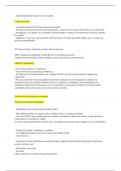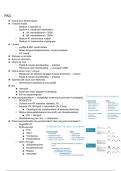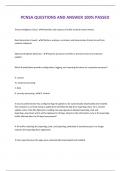Lecture 5 – Reasoning and Arguing: What is argumentation?
A (set of) proposition(s): alleged fact, valuation, policy
Standpoint Neutral Position
Positive P Negative not-P Doubt: why P Nil
Genuine With Standpoint
A normative model for critical discussion
1. Confrontation stage – difference of opinion?
2. Opening stage – where can we start from?
3. Argumentation stage – opponent convincing, critical testing
4. Concluding stage – resolved the difference?
Cooperation = avoid fallacies
Competition = avoid weak moves
Deliberation = practical problem solving “how to respond to the Brexit?”
Inquiry = theoretical problem solving “what caused the crash?”
Evading the Burden of Proof: you back out of your obligation to provide argumentation when
you are requested to do so.
“Everybody knows that!”
Shifting the Burden of Proof: you shift the burden of proof to your opponent.
A: “Why?” B: “Why not?”
Straw man: You attack a distorted, or exaggerated version of the interlocutor’s standpoint or
even a standpoint that you impute on him/her.
A: “I don’t want to donate my organs” B: “So you think you can let these people die?”
A: “More money should go to healthcare” B: “So you hate our country so much that you want to
cut military spending?”
Argumentum ad ignorantiam: You assume that if your antagonist cannot show you wrong, you
must be right
“There is no proof of fraud. Thus, the elections must have been fair.”
Single argumentation: One indivisible attempt at persuasion
Subordinative argumentation: Standpoint – substandpoint - subsubstandpoint, etc.
“Because” ”For that reason” “That is why” “Since”
Multiple argumentation: several independent defenses (of equal weight) of a standpoint
, “Needless to say” “In fact” “Apart from” “In the first place” “Aside from”
Coordinative argumentation: one defense made up from a number of dependent reasons
“As well as the fact that” “Don’t forget that” “Especially because” “On top of that”
Lecture 6 – The soundness of argumentation
A procedure for argument evaluation:
1. What is the structure of the argumentation? (lecture 5)
2. Tenability criticism
﮲ Are there any inconsistencies? Are the points of departure (basic premises)
acceptable?
3. Connection criticism
﮲ For connections presented as logically valid: does the reasoning contain a logical
mistake?
﮲ For connections presented as defeasibly correct: does the reasoning instantiate
an appropriate argument scheme that has been applied correctly?
4. Fallacy criticism
﮲ Are other fallacies committed?
Inconsistency: when not all expressed propositions can be true
Pragmatic inconsistencies: word-deed
May be pointed out, when:
﮲ The arguer appeals to his/her credibility
﮲ The allegation is correct
﮲ The pragmatic inconsistency cannot easily be explained away
﮲ The critic does not disqualify the other as a serious discussant altogether
Example of pragmatic inconsistency (tu qouque):
A: “Don’t smoke, it’s bad for your health.”
B: “But you smoke yourself!”
Different ways to show the acceptability of an argument
1. True
2. Acceptable as such
3. Acceptable for all participants, common ground
4. Acceptable for the antagonist, ex concessis
Rutte on religious non-vaccination “God didn’t mean to make kids suffer this way”
Two ways to present an argument:
1. As a correct application of a logically valid scheme
Modus ponens/modus tollens, etc.
Every S is a P. M is S. Therefore, M is P.
2. As a correct application of an appropriate argument scheme
S is a symptom of P. A is S. Therefore, A is P
Argumentation needs to be both logically valid and the application of an appropriate
argumentation scheme.
Linked with rule 7 and rule 8 of the Critical Discussion. Argument scheme rule and the validity
rule.
Valid argument: impossible for the conclusion to be false when all premises are true. It is only
formally valid when a right argumentation scheme will be applied.
A (set of) proposition(s): alleged fact, valuation, policy
Standpoint Neutral Position
Positive P Negative not-P Doubt: why P Nil
Genuine With Standpoint
A normative model for critical discussion
1. Confrontation stage – difference of opinion?
2. Opening stage – where can we start from?
3. Argumentation stage – opponent convincing, critical testing
4. Concluding stage – resolved the difference?
Cooperation = avoid fallacies
Competition = avoid weak moves
Deliberation = practical problem solving “how to respond to the Brexit?”
Inquiry = theoretical problem solving “what caused the crash?”
Evading the Burden of Proof: you back out of your obligation to provide argumentation when
you are requested to do so.
“Everybody knows that!”
Shifting the Burden of Proof: you shift the burden of proof to your opponent.
A: “Why?” B: “Why not?”
Straw man: You attack a distorted, or exaggerated version of the interlocutor’s standpoint or
even a standpoint that you impute on him/her.
A: “I don’t want to donate my organs” B: “So you think you can let these people die?”
A: “More money should go to healthcare” B: “So you hate our country so much that you want to
cut military spending?”
Argumentum ad ignorantiam: You assume that if your antagonist cannot show you wrong, you
must be right
“There is no proof of fraud. Thus, the elections must have been fair.”
Single argumentation: One indivisible attempt at persuasion
Subordinative argumentation: Standpoint – substandpoint - subsubstandpoint, etc.
“Because” ”For that reason” “That is why” “Since”
Multiple argumentation: several independent defenses (of equal weight) of a standpoint
, “Needless to say” “In fact” “Apart from” “In the first place” “Aside from”
Coordinative argumentation: one defense made up from a number of dependent reasons
“As well as the fact that” “Don’t forget that” “Especially because” “On top of that”
Lecture 6 – The soundness of argumentation
A procedure for argument evaluation:
1. What is the structure of the argumentation? (lecture 5)
2. Tenability criticism
﮲ Are there any inconsistencies? Are the points of departure (basic premises)
acceptable?
3. Connection criticism
﮲ For connections presented as logically valid: does the reasoning contain a logical
mistake?
﮲ For connections presented as defeasibly correct: does the reasoning instantiate
an appropriate argument scheme that has been applied correctly?
4. Fallacy criticism
﮲ Are other fallacies committed?
Inconsistency: when not all expressed propositions can be true
Pragmatic inconsistencies: word-deed
May be pointed out, when:
﮲ The arguer appeals to his/her credibility
﮲ The allegation is correct
﮲ The pragmatic inconsistency cannot easily be explained away
﮲ The critic does not disqualify the other as a serious discussant altogether
Example of pragmatic inconsistency (tu qouque):
A: “Don’t smoke, it’s bad for your health.”
B: “But you smoke yourself!”
Different ways to show the acceptability of an argument
1. True
2. Acceptable as such
3. Acceptable for all participants, common ground
4. Acceptable for the antagonist, ex concessis
Rutte on religious non-vaccination “God didn’t mean to make kids suffer this way”
Two ways to present an argument:
1. As a correct application of a logically valid scheme
Modus ponens/modus tollens, etc.
Every S is a P. M is S. Therefore, M is P.
2. As a correct application of an appropriate argument scheme
S is a symptom of P. A is S. Therefore, A is P
Argumentation needs to be both logically valid and the application of an appropriate
argumentation scheme.
Linked with rule 7 and rule 8 of the Critical Discussion. Argument scheme rule and the validity
rule.
Valid argument: impossible for the conclusion to be false when all premises are true. It is only
formally valid when a right argumentation scheme will be applied.






